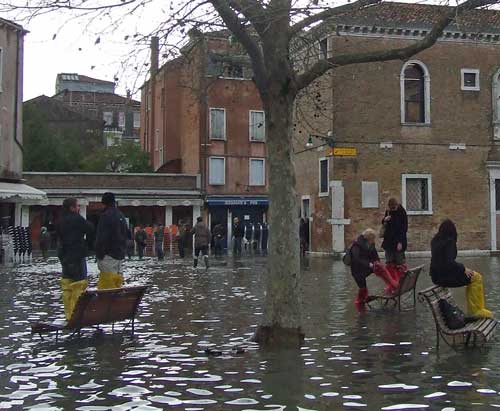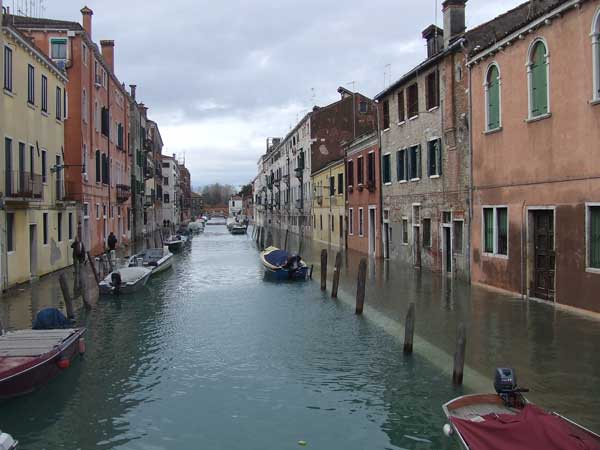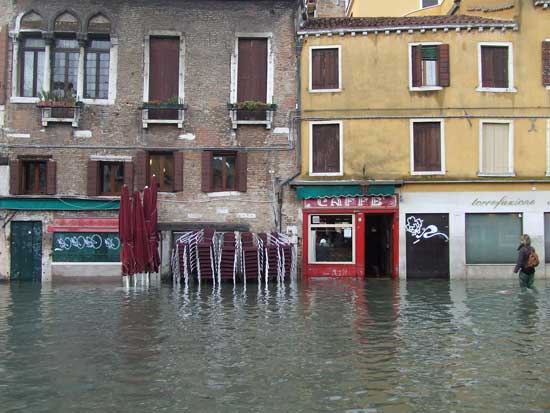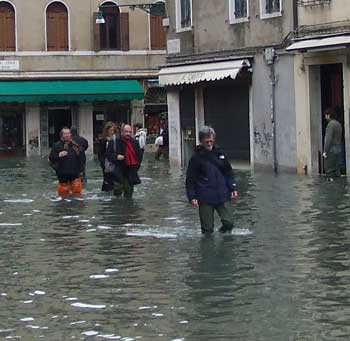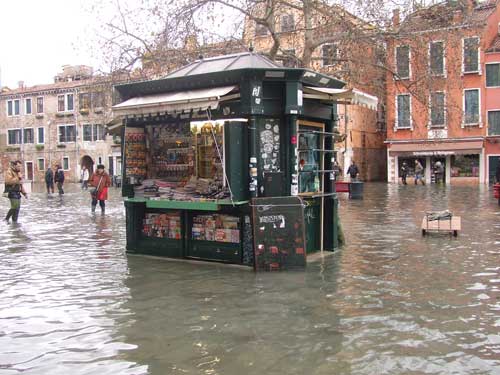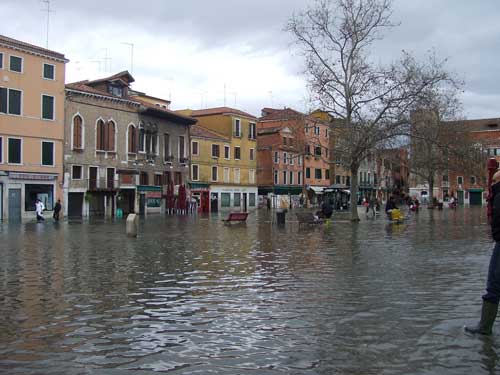> Venice floods – 1 December 2008
Find and book hotels in Italy. With location maps and guest reviews.
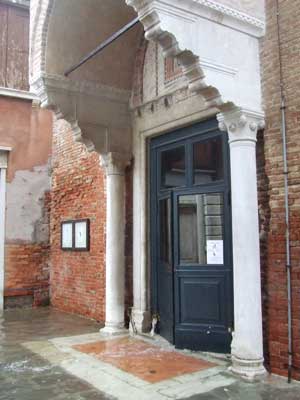
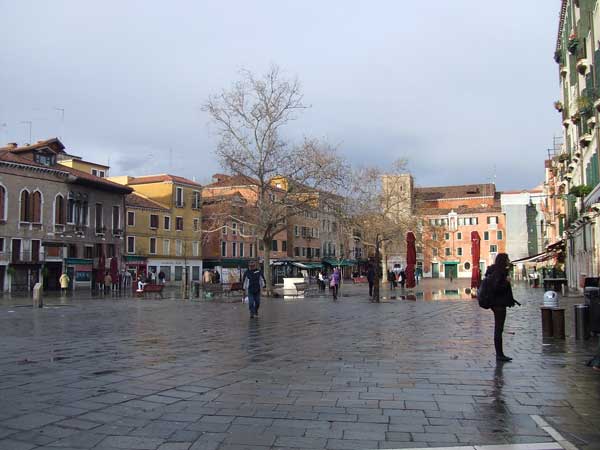
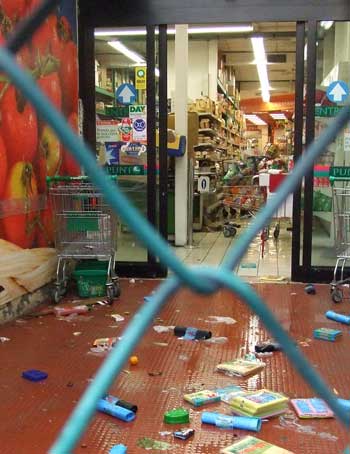
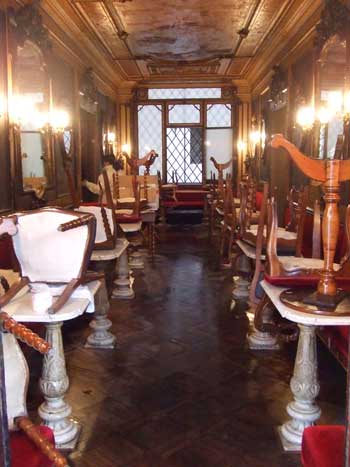
Venice floods: 1st December 2008
High water reaches dramatic levels and floods the entire city
On 1st December 2008 high water in Venice reached one of the highest-ever levels 156 cm above the average mid-tide measurement. The dramatic rise took most locals by surprise: the wind direction and overnight rain had added to an already-high lunar tide. I started the day in my ground-floor apartment here’s an account of an unusual day in Venice.
Ground floor as the water rises
Tides this week had been high because of the new moon. On several occasions the high tide had reached the top step leading down to the canal outside my house; maybe 105cm on the official scale. The high water measurements in Venice do not, as alarmist UK newspapers imply, mean that Venice is under a metre of water or more. It’s an island in a tidal lagoon; twice a day our canals rise and fall; the ‘zero’ measurement is just an average between high and low tide. Floods are very common in winter; the low-lying area around St. Mark’s Square is frequently flooded as high tide creeps up through the drains. At 100cm above the established average, the rest of the city is barely affected. A high tide of 120cm is infrequent but is likely to happen a few times each winter. Duck-boards are used to provide walkways along a few key routes; locals don Wellington boots.
The forecast for the morning tide had been around 110cm enough for me to think I might go and take my camera to see if there were any low floods. But as I lay half-awake at about 8:20am, I heard the new warning sirens. They sounded non-urgent, like pan-pipes: four rising notes. I knew that each note indicated an extra 10cm of tide above 1m. But my brain didn’t really process this warning of 140cm. I looked out of my window. Water was already lapping over the fondamenta (canalside pavement) outside my ground-floor apartment. I rang the tide warning phoneline. It was over 2 hours till high tide. A few students and locals passed outside in rubber boots, heading to work or university. Not having a radio or television I wondered what to do. There didn’t seem to be any sense of panic.
It seemed likely that the water would enter my home. Both the fondamenta outside and the apartment have been rialzato, ‘raised’; a technique used frequently over the centuries as Venice lifts itself above the increasing tides. My front door is up a low step from the fondamenta. Inside the flat there is a kind of door-well, large enough for the door to swing open, then another low step up to the level of my floor. I had been assured that this flat didn’t flood, but 140cm is rare, and perhaps the restored flat hadn’t been put to that test.
Venetians (and temporary Venetians) are all used to floods. Ground floors are not often inhabited; they are mostly shops or magazzini (storerooms). Even at my slightly raised ground-floor level, I lift valuables and electricals off the floor when leaving on winter trips. Today, as the water crept across the fondamenta towards my window, I moved everything off the floor and off bottom shelves, stacking them on the sofa, table and bed. I tied up the long curtains and hitched up the ‘skirt’ of the sofa.
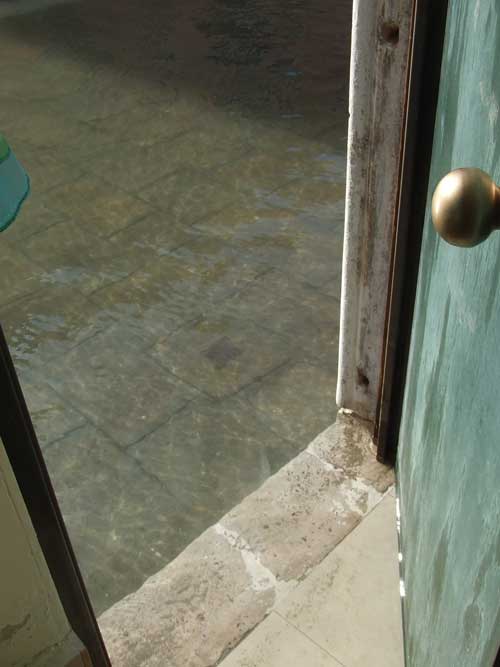
The warnings on the flood alert phoneline were getting more serious. Today is ‘Code Red’. Floods here are not dangerous to people the highest ever, the most destructive, was in 1966 and reached 194cm; even that would be wading-level for most of the city. But I could see that once the level on the fondamenta neared the top of my rubber boots, it would be tricky to evacuate. Should I leave while I could, and sit out the high tide at nearby Piazzale Roma? There, at the bus terminus, the ground is high and it would be easy to remain dry. Or should I stay and keep an eye on the flat, retreating up a few steps to my bed if necessary?
A couple of neighbours took their boats and left. Passers-by were beginning to have difficulties. Some teenagers wearing trainers were trying to clamber along from doorstep to doorstep above the water level. Other pedestrians without waterproofing were gathering on the bridge at the end of the canal, surveying the water in either direction.
Water oozes under the door. Stay or go? I make a cup of tea and sat down. Water fills the door-well. There’s an ominous glugging sound from the shower drain and the toilet flush is not behaving normally. I put on my rubber boots and open the door to look outside. The canal has expanded to fill the space from wall to wall, with no trace now of the two fondamente. First-floor residents are leaning out to take photographs. The flood-line now warns of a 160cm high tide at 12 noon still an hour away.
I inspect the water. It hasn’t quite edged over my internal step, and is swimming safely in the door-well. It doesn’t seem to be rising. A few minutes later I am almost sure it is actually subsiding. Then there is a public announcement made from the concealed loudspeaker warning system. I open the window to hear better. ..maximum 156cm at 10:45. The wind has changed direction; the water is leaving the city.
Floods in the city
This was the highest tide for 20 or 30 years. Residents are blasé about seeing the usual low-lying lanes under water, but today pretty much the entire city was covered by lagoon. Once I was confident the water was definitely going down, I put on my boots and joined the few locals and photographers most in thigh-high waders who were exploring the new townscape.
On each hump-backed bridge there were tiny knots of people: the unwary who had been stranded in ordinary shoes; tourists and students who had optimistically purchased plastic-bag style ‘boots’ or customised outer footwear from binliners, emptying out the water or abandoning their wet plastic. One or two people who’d rolled up their trousers and simply waded through the cold dirty water.
It was so strange to see the familiar canalsides and lanes swimming in water. White marble edges the fondamente, as a guidance to where pavement stops and canal begins. Boats passed with their wash ebbing around my boots. There’s a kind of etiquette to wading in boots; gliding steps, not splashing.
Just before Campo Santa Margherita I stopped on a bridge and surveyed the lane ahead. Water seemed perilously near Wellington-boot level. I watched a few people wade along and tried to gauge the levels and the slope of the paving. A lady waited on the bridge with her shopping, phoning a friend. A businessman with rubber boots waited patiently. Someone took out a book.
Carefully I waded along. The water didn’t quite top my boots but by this point one of them had sprung a leak anyway. I found myself in an unfamiliar scene. Campo Santa Margherita a long, irregular-shaped square was completely awash with water. Shops and businesses had their doors open and you could see the water inside; staff stood in wellies and chatted. The newspaper stand was open but surrounded by water. A few people perched on the back of benches I wondered if some had been there since the water first rose. At one end of the square a little gaggle of people stood calf-deep in water. The route out of the square was too deep for those of us with below-the-knee footwear. A man carried his girlfriend along; one or two resigned individuals waded, wet through. A girl tried hopping along in a big binliner. A lady carried her confused dog in her arms.
I tried the other direction; but after crossing a bridge I once more arrived at thigh-level waters. ‘Closed that way.’ People were exchanging information about routes which could be braved. The lucky ones in high waders were the only ones who could move freely around Venice while the water was at its highest: some were photographers, others were locals viewing the scene; some were heading to inspect premises or just to go about their daily chores.
Unable to reach any shop which might still have stocks of rubber boots or waders, I paddled into a flooded local shop where it was business as usual. Staff and customers were in Wellingtons, wading, though no-one bothered to comment on the situation. I bought some milk and bread and sloshed back home to empty out my boots.
The aftermath
The water had gone down to much more normal levels by mid-afternoon, though to read the UK papers you’d think Venice was still drowning. Although some spots were still under water, people were briskly going about their normal business. Some even had ordinary shoes on we were no longer a smug rubber-booted band of survivors. Venetians are hardy souls, and unusually business-like for Italians. I saw shopkeepers pumping water over the futile metal boards which normally keep the high tide at bay. By late afternoon, every shopkeeper in town was mopping floors and counting the cost; some were reopened for business. In an office I visited, water had seeped into computers. Rugs, antiques and furnishings were standing outside to dry.
As I passed, I saw water cascading out of the Carmini church, seemingly draining away of its own volition at an astounding rate. Inside the marble tiles were still drowned. I had cunningly-devised plastic-bag extensions to my wellies (copied from a local), but the extra protection was not needed. I squelched around town towards St. Mark’s. A few enterprising stalls were selling boots from boxes labelled with their sizes: 39, 40. It’s a shame they are so hard to get hold of when you really need them.
In Piazza San Marco there was still some water lying in the square. This is always the first place to flood and will probably be the last to dry. Tourists took photos; to them this low level of water was still a marvel though it was a puddle compared to the excesses of a few hours previously.
By early evening the main signs of the flood were bits of detritus and rubbish that had been carried about by the waters, and the cleaning-up activities taking place everywhere. Street lights weren’t working in parts of San Polo, near the Rialto. And many shops and restaurants, away from the tourist hub, were closed. Residents met in the bars which had opened to compare notes. Some parts of the town had lost electricity. Cashpoints hadn’t worked. Friends had been marooned in their houses. Goods kept in the storerooms had been damaged. Water had ruined books on the lowest shelves in a local bookshop. There was some anxiety for he following morning (high tide forecast of 110cm; always the possibility of adverse wind).
2nd December update: today it is business as usual in Venice. There was a high tide this morning, but only just over 100cm; nothing like yesterday. Around town, almost every shop and business seemed to have re-opened, although there was still some cleaning being done, with mops and buckets much in evidence. Shops were re-stocking their lower shelves, and trying to fix spluttering fridges. The local newspaper (sold out) records the historic occasion (the fourth-highest water level recorded) and discusses the various debates. Why was the forecast wrong by nearly 50cm? Should more have been done? Why did a programmed public transport strike go ahead, making it impossible to get around the city? Why were Venice’s rubbish-collectors deployed setting up duckboards which are useless at such high water levels, leaving rubbish bags to bob around in the flood? And how much will it cost the city, and individual residents to put right all the damage?
The biggest debate of all will be over the infamous MOSE floodgates, designed to protect Venice from the sea, but widely criticised for being a misuse of public money and possibly counter-productive. Work is still underway on the project, which many would like to see abandoned. This damaging flooding will have stirred up opinions even more. Was it just an unusually high tide (the philosopher-mayor’s view), a disaster, a turning point or a simple adventure?
4th December update: Venetians are so upset about some of the garbled, misleading accounts in foreign newspapers that local businesses are even trying to find a way to launch legal proceedings, according to the local press. There was a knee-high flood which lasted a couple of hours – no reason to stay away from Venice. Unfortunately respected newspapers like The Times reported the mayor in a misleading context (the only time it would have been sensible to ‘stay away from Venice’ would have been Monday morning, when it wouldn’t have been practical to arrive with suitcases and drag them around town.) Venice was never ‘under five foot of water’; overseas journalists simply misunderstood the city’s tidal measurements. The bolder hotels are now considering offering tourists ‘flood packages’ – where they will supply news, wellies and the opportunity to enjoy the spectacle of the city’s high tides as part of Venice’s attractions. Cancelled holidays are quite likely to cost the city far dearer than the actual flood damage.
> General information about high tides in Venice
Useful links
Information about acqua alta in Venice
External links
